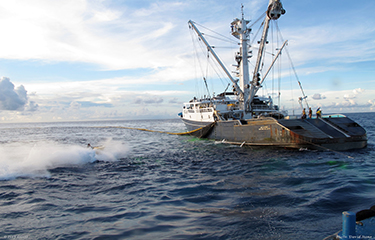Ahead of ICCAT meeting, NGOs call for better harvest strategies for Atlantic bigeye, yellowfin tuna fisheries

Ahead of the International Commission for the Conservation of Atlantic Tunas’ (ICCAT) meeting, which will run from 13 to 20 November in Cairo, Egypt, an array of NGOs are calling on the regional fishery management council to improve management practices and develop a plan to rebuild the stocks of overfished bigeye and yellowfin tuna fisheries.
ICCAT meets annually to discuss management members for tuna and tuna-like species, which includes sailfish, blue marlin, swordfish, several species of shark, and more. Before the meeting, environmental NGOs regularly put out calls for action to the commission; last year, The Pew Charitable Trusts pushed for the adoption of a harvest strategy for bluefin tuna.
This year, multiple NGOs and groups representing retailers are calling on the commission to establish a strategy to rebuild the Atlantic bigeye tuna stock, to maintain yellowfin tuna stocks within the total allowable catch (TAC), and establish a management procedure for skipjack tuna.
ICCAT issued a report in 2018 that declared Atlantic bigeye tuna as overfished. In 2019, the organization responded by reducing fishing efforts for bigeye tuna to start rebuilding the stock, but in 2021, NGOs cautioned its plan to increase fishing quotas and reduce closure periods on fish aggregating devices (FADs) could increase the risk of overfishing.
Now, nonprofit groups are again calling on ICCAT to establish a long-term plan for rebuilding bigeye tuna stocks.
The Global Tuna Alliance, a group of 49 retailers and tuna supply chain companies, said it wants ICCAT to create a multi-annual plan to rebuild tuna stocks within the next 15 years. Typically, the RFMO establishes a plan for the stock each year.
“ICCAT are, in effect, recycling the same plan over and over again. But it takes a lot of energy to have to meet each year to agree to keep rolling over the same measure,” GTA Director of Outreach and Engagement Albert Arthur said in a release. “It would take a lot less energy for delegates, and deliver a lot more certainty to tuna purchasers if a multi-annual solution was reached.”
From a retailer perspective, Arthur said, a stable supply of a resource is essential and ICCAT’s current year-by-year strategy could end up leaving them high and dry if things change.
“And who loses out if businesses decide it’s not worth the risk? The economies of those producing countries who cannot reach a long-term agreement on catch allocations,” he said.
The GTA is pushing for ICCAT to adopt an allowable catch that would result in a greater than 60 percent chance of success at rebuilding the stock within 15 years. It is also calling for a precautionary TAC for yellowfin tuna that is within scientific advice and allocated between fishing gears and member countries.
The International Seafood Sustainability Foundation (ISSF) is also pushing for better rules covering yellowfin and bigeye tunas. According to the foundation the yellowfin TAC has been exceeded every year but one since it first came into effect in 2012, and in 2022, catches were almost 35 percent higher than the TAC. The ISSF is also pushing for an updated bigeye assessment in 2025 to ensure the health of the stock.
The Pew Charitable Trusts, meanwhile, is pushing for a new management procedure for North Atlantic swordfish.
In the 1990s, the Atlantic swordfish fishery nearly collapsed after decades of fishing, triggering cuts and catch limits. While the population has been stable for the last decade, Pew said, fisheries are facing uncertainty as climate change begins to shift ocean temperatures.
To counter the uncertainty, Pew is calling on ICCAT to adopt a harvest strategy for the species focusing on long-term objectives. A harvest strategy also comes with pre-determined rules that can kick in based on changes in the stock.
Other NGOs are calling on ICCAT to strengthen regulations to protect populations of sharks in the Atlantic. A report by Shark League, an organization devoted to the protection of sharks and rays, found that some of ICCAT’s rules have key implementation and policy gaps. The report also looked at how the Convention on International Trade in Endangered Species (CITES) interacts with ICCAT rules – and where it too is failing.
“ICCAT and CITES have both advanced shark and ray conservation, and both bodies face major implementation challenges stemming from inadequate resources and insufficient political will,” Shark Advocates International President Sonja Fordham said.
Shark Trust Director of Conservation Ali Hood said endangered sharks and rays often get less attention from RFMOs because they tend to be less valuable commercially, providing less of a market incentive to address problems. Many countries are also not reporting oceanic shark landings, the Shark League said, making it difficult to determine what the population is.
“We must balance the attention given to achieving conservation agreements with the fulfillment of commitments, particularly limits on fishing and trade,” Hood said.
In addition to improvements to population management measures, NGOs are also calling on ICCAT to adopt measures to increase observer coverage on longline vessels from 10 percent to 100 percent, establish additional transshipment regulations to remove potential conduits for illegal, unreported, and unregulated (IUU) fishing, and to establish better management of FADs.
Photo courtesy of the ISSF/David Itano






Share